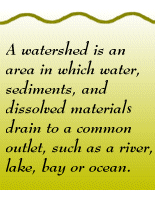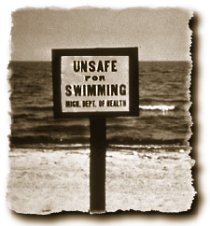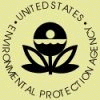Water: Oceans, Coasts, Estuaries & Beaches
Coastal Watershed Factsheets - The Beach and Your Coastal Watershed

| United States Environmental Protection Agency |
Office of Water (4504F) |
EPA 842-F-98-010 April 1998 |

![]() eaches are an important part of the complex and dynamic coastal watershed. Lake, river, and ocean beaches are America's top vacation choices. We take almost two billion trips to the beach each year and spend billions of dollars in beach communities. Inadequate protection and overuse of beaches can lead to their alteration or destruction. However, some simple actions can be taken to protect these valuable systems.
eaches are an important part of the complex and dynamic coastal watershed. Lake, river, and ocean beaches are America's top vacation choices. We take almost two billion trips to the beach each year and spend billions of dollars in beach communities. Inadequate protection and overuse of beaches can lead to their alteration or destruction. However, some simple actions can be taken to protect these valuable systems.
What Is a Beach and What Does It Do?
The U.S. Environmental Protection Agency (EPA) defines a beach as "the area of unconsolidated material, such as sand, pebbles, or rocks, that extends landward from the low water line to the place where there is marked change in material or physiographic form, or to the line of permanent vegetation (usually the effective limit of storm waves)." In other words, a beach is the sandy, pebbly, or rocky shore of a body of water.

Beaches vary widely in physical type and characteristics. When most of us think of a beach, we picture sandy ocean beaches with waves crashing, wind blowing, and seagulls flying overhead. But beaches in the United States also include urban seashores, estuarine and lagoonal beaches, and freshwater lakefronts and riverfronts.
Ocean beaches-- Ocean beaches vary along our coasts. The Atlantic coast, for example, includes a system of barrier beaches influenced by high-energy wave action. The coasts of the Gulf of Mexico are calmer, with less wave action and more submerged vegetation like sea grasses. The Pacific region has some mountainous  coastlines and volcanic islands. The plants and animals of each area are different from those of other beaches; the sand texture, color, and consistency even vary. For example, Hawaii is famous for its black sand beaches, a result of volcanic activity on the islands.
coastlines and volcanic islands. The plants and animals of each area are different from those of other beaches; the sand texture, color, and consistency even vary. For example, Hawaii is famous for its black sand beaches, a result of volcanic activity on the islands.
Urban seashores, freshwater lakefronts, and riverfronts-- Since goods were transported via water "highways" before the invention of trains and trucks, many American cities developed along riverfronts, ports, and lakes. Cities like Boston, St. Louis, Chicago, and San Diego have urban seashores, riverfronts, or lakefronts. These areas provide recreational opportunities for many city dwellers.
 Estuarine/lagoonal beaches-- Some coastal areas, influenced by river systems, form deltas, bays, and extensive estuarine and lagoonal beaches. An estuary is an area where freshwater empties into and mixes with saltwater. The shorelines within estuaries can be vegetated with many types of plants, including mangroves and sea grass beds. These areas are important breeding grounds for a variety of fish, shellfish, and shorebirds. The Chesapeake Bay, Galveston Bay, and San Francisco Bay are all examples of estuarine systems.
Estuarine/lagoonal beaches-- Some coastal areas, influenced by river systems, form deltas, bays, and extensive estuarine and lagoonal beaches. An estuary is an area where freshwater empties into and mixes with saltwater. The shorelines within estuaries can be vegetated with many types of plants, including mangroves and sea grass beds. These areas are important breeding grounds for a variety of fish, shellfish, and shorebirds. The Chesapeake Bay, Galveston Bay, and San Francisco Bay are all examples of estuarine systems.
A beach-- whether ocean, urban, or estuarine-- serves a variety of functions:

-
The beach provides a unique habitat for a variety of plants and animals. For example, 75 percent of migratory waterfowl live in or depend on coastal beaches during their life span. Dune vegetation provides nesting areas for several kinds of birds and animals. The types of species found on a beach are determined by the type of beach. In the hot, wet climate of the tropics, mangrove trees dominate estuarine/lagoonal beaches. In the harsher climate of New England, beaches are dominated by a few species of hardy grasses and bushes that can withstand strong winds, cold winters, and intense summer sun.
-
Stretches of beach along the coasts of the United States provide numerous recreational opportunities for millions of people. Boating, fishing, swimming, walking, beachcombing, bird-watching, and sunbathing are among the numerous activities enjoyed by beachgoers. The aesthetic aspects of a beach system provide additional benefits, even inspiring works of art and literature.
-
Beaches provide some protection to residents living near the ocean. They act as a buffer against the high winds and waves of powerful storm systems or turbulent seas.


Why Can't We Use the Beach Sometimes?
Pollution of coastal environments threatens the use of beaches as an economic, recreational, and aesthetic resource. Impacts can result from activities occurring on the beach itself or from points within the coastal watershed that drain to an area of the beach. Marine debris, such as litter left on the beach after a picnic, is an example of a local impact. Some typical impacts from activities farther up in the watershed include poor water quality from excessive nutrients (in the form of fertilizers draining from lawns or agricultural fields within the watershed); and from litter washed into storm drains and eventually reaching the beach. Litter can make it unsafe to walk on the beach; pathogens or algae blooms can make it unsafe to swim; and other pollutants can make it unsafe to eat the fish or shellfish caught from the waters.
Some Impacts on Beaches

People using the beach and the areas directly offshore can damage beach resources. The beach is a sensitive, dynamic environment that provides habitat for a variety of plants and anlimals. Excessive use of the beach can lead to the gradual degradation of habitat. Impacts on dunes due to foot traffic can lead to erosion and destruction of vegetation. Frequent boat traffic too close to the shoreline, particularly along lakefronts and riverfronts, can cause excessive wave action that can lead to beach erosion. Trash dumped from boats can be washed up onto the beach, posing a threat to human and marine species. When boat sewage is not disposed of properly, pathogens and nutrients can enter the water, degrading water quality.

Marine debris is trash floating on the ocean or washed up on beaches. It comes from many sources, including beachgoers, improper disposal of trash on land, storm water runoff to rivers and streams, ships and other vessels, and offshore oil and gas platforms. Marine debris can seriously affect wildlife, the environment, people, and our economy. Communities can lose considerable income when littered beaches must be closed or cleaned up.
An excessive amount of nutrients from land -based sources such as failing septic tanks, sewage treatment plants, boating wastes, deposition from air, industrial organic waste discharge, and contaminated runoff from fertilized farms or yards or from animal feeding operations can adversely affect the beach. Some of these impacts include harmful algal blooms and fish kills. Outbreaks of the toxic microorganism Pfiesteria piscicida have been linked to excessive nutrients in the affected waters.
Pathogens threaten human health and cause beach closures. The most frequent sourcmes of disease-causing microorganisms, or pathogens, are sewage overflows, polluted storm water runoff, sewage treatment plant malfunctions, boating wastes, and malfunctioning septic systems. Swimming in or ingesting waters contaminated with pathogens can result in human health problems such as sore throat, gastroenteritis, or even meningitis or encephalitis. Pathogens can also contaminate shellfish beds.

Land development activities within the coastal watershed can have serious consequences for beaches. Clearing of land for obtaining timber, the construction of homes and roads, and other development projects completed without properly revegetating the area can lead to excessive sediments being washed into the system. These sediments are deposited downstream along coastal shorelines. Not only do excessive sediments muddy the water and make it unappealing to swim in, but they can also carry excessive nutrients and pesticides, causing water quality problems. Land development directly on the beach can destroy the dune and beach ecosystem and increase erosion of beaches. This can result in the need for costly beach "renourishment" projects. In addition, coastal storms may be more damaging because natural barriers are removed in the process of development.
What Is EPA Doing to Protect Beaches?
BEACH Program-- EPA, through its Beaches Environmental Assessment, Closure and Health (BEACH) Program, is working with state, tribal, and local governmental partners to make sure beach water quality information is available to the public. EPA established the BEACH Program to provide a framework for local governments to develop equally protective and consistent programs across the country for monitoring the quality of water at beaches and posting warnings or beach closings when pollutant levels are too high.
Marine debris-- EPA is also committed to protecting human and environmental health from marine debris by working with other federal agencies to develop citizen monitoring and clean-up  patrols and to build public awareness about marine debris. These programs include financial support to the International Beach Cleanups organized by the Center for Marine Conservation, national marine debris information offices, public service announcements, and development of methods for volunteer clean-up efforts.
patrols and to build public awareness about marine debris. These programs include financial support to the International Beach Cleanups organized by the Center for Marine Conservation, national marine debris information offices, public service announcements, and development of methods for volunteer clean-up efforts.
Pollution discharge- EPA also works closely with the U.S. Army Corps of Engineers in the use of dredged material to restore beaches damaged by erosion. EPA works with the U.S. Coast Guard to regulate the transportation of municipal and commercial waste on vessels and to issue regulations for the manufacture, maintenance, and efficiency of marine sanitation devices (boat toilets), as well as the establishment of "no discharge zones" for vessel sewage. All of these efforts enhance coastal water quality. EPA also implements programs to control the direct and indirect discharge of pollutants to beach areas. Laws and regulations prohibit the direct discharge of pollutants (point source pollution) to water bodies. Voluntary programs help prevent the indirect discharge of pollutants (nonpoint source pollution) to water bodies.
What Can You Do to Help Protect Beaches?
The most effective way to reduce beach closures is pollution prevention, which starts at home. Conserving water, keeping septic systems properly maintained, properly disposing of trash and pet waste, and using natural substances like compost to fertilize gardens are just a few examples of how you can make a difference. When you are enjoying the beach, such simple acts as putting your trash in the proper receptacles and using walkovers instead of walking across the sensitive dune systems can maintain the beach for continued use by you and others. You can dispose of boat sewage in onshore sanitary facilities instead of dumping it into the water. Many coastal communities organize beach cleanups in which you can participate, an enjoyable way to ensure your beach stays trash-free.
|

Call EPA's Oceans and Coastal Protection Division at or write to: |
